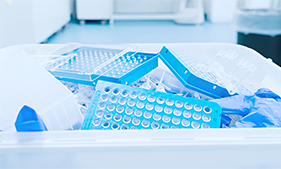Why Labs Need to Prioritize Sustainability
The mission of improving lab sustainability is quickly becoming a top priority in both the private and public sectors. More than 70 countries have joined the Race to Zero3 coalition to pledge to cut greenhouse gas emissions as close to zero as possible. Despite recent legislation4, the U.S.is still not on track to meet its Paris Accord goal of a 50% emissions reduction by 2030. As a result, more responsibility falls upon private businesses and individuals to enact and meet their sustainability goals. The financial and environmental benefits of sustainable practices are prompting leaders in the scientific community to embrace these changes and move initiatives forward.
The proven financial benefits of reducing carbon emissions are a practical motivator for labs to switch to a sustainable model. Institutional investors are showing a strong preference for companies that are prioritizing decarbonizing their portfolios, and with good reason. According to the NYU Stern Center for Sustainable Business5, sustainability initiatives drive better financial performance. Analysis has shown6 that the actions associated with reducing emissions can increase financial performance by driving innovation and improving risk management. Investors, regulators, and customers are looking for organizations with articulated carbon reduction goals and actionable strategies. To thrive, labs and businesses need to be transparent regarding their commitments to achieving a low-carbon future.
How to Reduce Energy and Water Consumption in the Lab
Reducing water and energy use is an effective first step when creating a sustainability plan. Scientific facilities are notorious for energy and resource consumption. According to the U.S. Department of Energy (DOE), the Federal Energy Management Program7 estimates that labs use between three and ten times more energy and water than a typical commercial office building. Labs have a unique opportunity to make a significant environmental impact by evaluating the processes they currently have in place.
Labs can take a creative approach to reducing resources through the mindful use of machines and devices. Anyone within a lab can make these changes immediately without a significant change in processes:
- Turn off lights at appropriate times
- Conduct regular maintenance of machines and devices to ensure they run smoothly
- Turn off or unplug appliances when not in use
- If purchasing new equipment, consider high-efficiency machines
- Keep the heating and cooling moderate. Create microenvironments when needed
- Weigh the impact of single-use plastics against the water and chemicals required to sterilize reusable lab equipment
These small changes can have a significant financial impact. For example, an MIT lab8 calculated that they were spending $30,000 on electricity and releasing more than 163 tons of carbon dioxide annually. By slightly increasing freezer temperatures, replacing lights with more efficient LED bulbs, and turning off one fume hood, the lab reduced its energy usage by eightpercent and saved $2,500 annually. Bringing more awareness to daily water and energy usage in the lab can prompt action that produces both financial and environmental benefits.
How to Reduce Waste at the Lab Bench
Reducing waste minimizes landfill contributions and prevents labs from spending funds on materials that could have been saved or reused. When conducting experiments, it is vital to think through the process strategically with lab sustainability in mind. A scientist can significantlyreduce waste by taking the time to create a plan before running an experiment. Before beginning a protocol, ask:
- Can reaction volumes be reduced or scaled down?
- How can waste be reduced in this experiment?
- Can I reuse materials from previous experiments?
Proper maintenance and routine servicing of instruments are foundational for lab sustainability. Well-maintained, high-performing machines minimize the need to waste reagents or other consumables on repeating experiments due to suboptimal data. After running an experiment, determine if the consolidation of reagents is possible. Store any unused materials from kits or leftover reagents for reuse. Accurate labeling can eliminate overordering and extend the life oflab supplies on-hand. With strategic preparation, proper maintenance, and consistent planning, a scientist can make a significant positive impact within their existing workflow.
How to Create a Sustainable Sourcing Strategy
Proper planning is the key to developing a solid lab sustainability strategy. From materials sourcing to manufacturing and transportation, choosing suppliers that prioritize sustainability greatly reduces a lab’s overall carbon emissions.
Below are some additional easy-to-implement lab sustainability tips:
- Switch to glass containers where possible
- Purchase reagents and consumables in bulk to avoid excess packaging
- Choose consumables with recyclable packaging
- Purchase from suppliers with sustainable product production or manufacturing materialsin-house using environmental production practices
- Choose local suppliers to reduce the carbon emissions associated with transportation
- Partner with local recycling centers that offer capabilities to recycle lab plastics
Partnering with specialized companies that handle the recycling of unique materials like hazardous waste or gloves can significantly reduce the lab's environmental impact. Properly managing resources and choosing sustainable lab supplies will put a lab ahead of the curve in reducing overall carbon impact.
How to Create an Internal Recycling Protocol
In 2017, China announced that it would no longer accept plastic waste from the U.S., intensifying the need to find local, state, and national methods for recycling. To further complicate matters, not all lab plastics can be recycled. Polyethylene terephthalate (PET) is the most recyclable plastic and is in high demand as a source material, but many lab plastics vary in grade. The options available to labs for recycling plastics may also vary due to geographic location and local and institutional regulations. Before recycling lab plastics, identify items that can be reused (e.g., pipette tip boxes and reagent bottles), separate items that are biohazardous for hazardous waste processing, and sort nonhazardous plastics for recycling.
Many labs have internal protocols for recycling guidance. For labs without protocols, staff and stakeholders can talk to lab management about creating one. It is helpful to post instructions near waste receptacles throughout the lab after establishing a system. This will ensure that all lab employees understand what is recyclable and what they can dispose of. A well-established protocol for identifying recyclable materials and diverting waste from landfills is key to a sustainable lab.
How to Start Conversations about Lab Sustainability
It takes only one person to begin the discussion on how to make a lab more sustainable, but it takes a team to follow through. The first step in developing sustainable lab practices is understanding the waste generated within your lab and how it impacts the environment. Moving toward implementation takes the cooperation of every individual within the lab, from technicians to the PI.
Prompting a discussion on implementing sustainability practices is the first step. Here are a few great ways to spark the conversation:
- Prepare: Strategize by first analyzing the lab’s processes and where sustainability practices can be implemented
- Calculate: Demonstrate how lab sustainability could be financially beneficial and show examples of other labs that have reduced energy consumption and operating costs
- Illustrate: Lay out what a sustainability plan would look like, what actions would be taken, and who would be responsible for implementing them
- Take Ownership: Follow through by developing a sustainability plan, create milestone dates, and hold other lab members accountable for reaching implementation landmarks
Learning how to make a lab more sustainable can be overwhelming. Below are a few tools and resources to help you create a lab sustainability plan.
Lab Sustainability Resources to Get Started
The journey to becoming carbon neutral can be an engaging team activity within the lab. Several resources are out there to help generate excitement for everyone to participate in sustainability practices. Certification programs like My Green Lab9 help labs focus on ways they can save energy and water, reduce carbon emissions, and build a new culture of resource preservation. They provide fun and interactive activities that lab employees can engage in. With EcoVadis10 sustainability scores, labs can quickly turn sustainability practices into a competitive challenge.
Labs can also sign onto broad sustainability initiatives, like the Science-Based Targets initiative11 (SBTi) and the Health Care Sector Pledge12, that can provide additional assistance and resources to companies and institutions looking to reduce their carbon emissions.
The Labs of the Future Are Sustainable
The changes required to start the process toward sustainability are simple. Small shifts in operations, sourcing, and waste disposal can be immensely impactful. Labs that switch to more sustainable practices will find greater efficiency, financial savings, and most important, a balance between research and environmental preservation.
References
- Urbina MA et al. (2015). Labs Should Cut Plastic Waste Too. Nat 528, 479.https://doi.org/10.1038/528479c, accessed August 18, 2022.
- O 'Brien T (2022). Lab Manager. Reducing Waste in The Lab: Quick tips to minimize the environmental impact of lab experiments. labmanager.com/business-management/reducing-waste-in-the-lab-27829, accessed August 18, 2022.
- United Nations. Race to Zero: For a livable climate: Net-zero commitments must be backed by credible action. un.org/en/climatechange/net-zero-coalition, accessed August 18, 2022.
- H.R.5376. 117th Congress (2021–2022): Inflation Reduction Act of 2022. congress.gov, accessed August 18, 2022.
- NYU Stern Center (2021). New Meta-Analysis From NYU Stern Center for Sustainable Business and Rockefeller Asset Management Finds ESG Drives Better Financial Performance. stern.nyu.edu/experience-stern/faculty-research/new-meta-analysis-nyu-stern-center-sustainable-business-and-rockefeller-asset-management-finds-esg, accessed August 18, 2022.
- ESG and Financial Performance. Uncovering the relationship between ESG and financial performance through meta-analysis of 1,000+ studies. stern.nyu.edu/experience-stern/about/departments-centers-initiatives/centers-of-research/center-sustainable-business/research/research-initiatives/esg-and-financial-performance, accessed August 18, 2022.
- Office of Energy Efficiency and Renewable Energy. Federal Energy Management Program. energy.gov/eere/femp/federal-energy-management-program, accessed August 18, 2022.
- Madhusoodanan J (2020). What can you do to make your lab greener? DIY approaches help to minimize plastic use and energy waste in science research. Nature. nature.com/articles/d41586-020-01368-8?proof=tr+%C2%A0, accessed August 18, 2022.
- My Green Lab. My Green Lab Certification: A Commitment to Sustainable Science. mygreenlab.org/green-lab-certification.html, accessed August 18, 2022.
- EcoVadis: The World’s Most Trusted Sustainability Ratings. ecovadis.com, accessed August 18, 2022.
- Science Based Target Initiatives: Ambitious Corporate Climate Action. sciencebasedtargets.org, accessed August 18, 2022.
- U.S. Department of Health & Human Services. Health Care Sector Commitments to Emissions Reduction and Resilience. hhs.gov/climate-change-health-equity-environmental-justice/climate-change-health-equity/actions/health-care-sector-pledge/index.html, accessed August 18, 2022.








